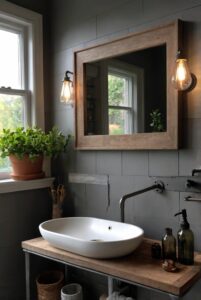In today’s daily interior designer routine, learn how to effortlessly install a sleek vessel sink in your bathroom to elevate its aesthetic appeal.
To install a vessel sink in your bathroom, start by turning off the water supply. Disconnect the water lines and remove the old sink. Check if the new vessel sink fits the countertop cutout. Apply silicone adhesive to the underside of the sink to secure it in place. Reconnect the water lines and install the drain assembly.
This installation process enhances your home decor interior design by adding a modern touch to your bathroom. Properly installed vessel sinks can improve the aesthetics and functionality of your space. Be mindful of water leakage risks, ensuring tight connections and applying sealant.
For a seamless home interior design, consider coordinating the vessel sink with your existing decor elements. Match the sink color with the paint scheme for a cohesive look. By following these steps, your bathroom will be transformed into a stylish and functional space.
To install a vessel sink in your bathroom, follow these steps:
1. Measure and Prepare:
Before you start the installation process, measure the dimensions of the sink and the countertop opening to ensure a proper fit. Make sure the countertop can support the weight of the vessel sink. Prepare all the necessary tools and materials, including the sink, faucet, drain assembly, silicone sealant, and plumber’s putty.
2. Install the Faucet:
Begin by installing the faucet on the countertop according to the manufacturer’s instructions. Make sure the faucet is securely in place before proceeding to the next step. This is a crucial step in ensuring proper functionality and aesthetics of the vessel sink.
3. Position the Sink:
Carefully position the vessel sink over the countertop opening. Ensure that the sink is centered and level before proceeding with the installation process. Use a pencil to mark the outline of the sink on the countertop to guide you during the next steps.
4. Seal and Secure the Sink:
Apply a bead of silicone sealant around the bottom edge of the vessel sink. Carefully place the sink back onto the countertop and press it down firmly to create a watertight seal. Wipe off any excess sealant that may squeeze out from the edges. Secure the sink in place by tightening the mounting hardware provided by the manufacturer.
5. Connect the Drain:
Connect the drain assembly to the sink according to the manufacturer’s instructions. Use plumber’s putty to create a watertight seal around the drain opening. Attach the P-trap and other necessary plumbing components to complete the installation process.
In conclusion, installing a vessel sink in your bathroom can add a touch of elegance and modernity to your space. By following these steps carefully and ensuring proper measurements and sealing, you can successfully install a vessel sink in your bathroom. Remember to consult the manufacturer’s instructions for specific details related to your sink and faucet.
1. How do I prepare the countertop for a vessel sink installation?
To prepare the countertop for a vessel sink installation, you will need to measure and mark the center point where the sink will be placed. Next, trace the outline of the sink on the countertop and use a jigsaw to carefully cut out the opening. Ensure that the countertop is sturdy enough to support the weight of the sink and make any necessary reinforcements if needed. Finally, apply a bead of silicone around the edge of the sink opening to create a watertight seal once the sink is in place.
2. What tools and materials do I need to install a vessel sink in my bathroom?
To install a vessel sink in your bathroom, you will need a few essential tools and materials. These include a jigsaw or hole saw for cutting the opening in the countertop, a drill for making pilot holes and installing the faucet, a wrench for tightening the faucet and drain connections, plumber’s putty or silicone sealant for creating a watertight seal, and a level to ensure the sink is properly positioned. Additionally, you may need a bucket, towels, and cleaning supplies to clean up any mess during the installation process.
3. How do I secure the vessel sink to the countertop?
Once you have prepared the countertop and placed the vessel sink in the opening, you will need to secure the sink to the countertop to prevent it from shifting or moving. To do this, apply a thin bead of silicone sealant around the underside of the sink where it meets the countertop. Press the sink firmly into place and wipe away any excess sealant. Allow the sealant to cure according to the manufacturer’s instructions before using the sink. This will create a strong bond between the sink and countertop, ensuring a secure installation.
4. Can I install a vessel sink without professional help?
Installing a vessel sink in your bathroom is a project that can be completed by confident DIYers with basic plumbing and carpentry skills. With the right tools, materials, and instructions, you can successfully install a vessel sink on your own. However, if you are unsure about any aspect of the installation process or encounter any difficulties, it is always best to seek professional help. A licensed plumber or contractor can ensure that the sink is installed correctly and safely, reducing the risk of leaks or damage to your bathroom.
5. What are some tips for maintaining a vessel sink after installation?
To keep your vessel sink looking great and functioning properly after installation, there are a few maintenance tips to keep in mind. Regularly clean the sink with a mild soap or non-abrasive cleaner to prevent soap scum and mineral deposits from building up. Avoid using harsh chemicals or abrasive scrubbers that could damage the sink’s finish. Check the faucet and drain connections periodically for any signs of leaks or corrosion and tighten any loose connections as needed. Finally, consider applying a protective sealer to the sink to help maintain its appearance and protect it from stains and water damage.




